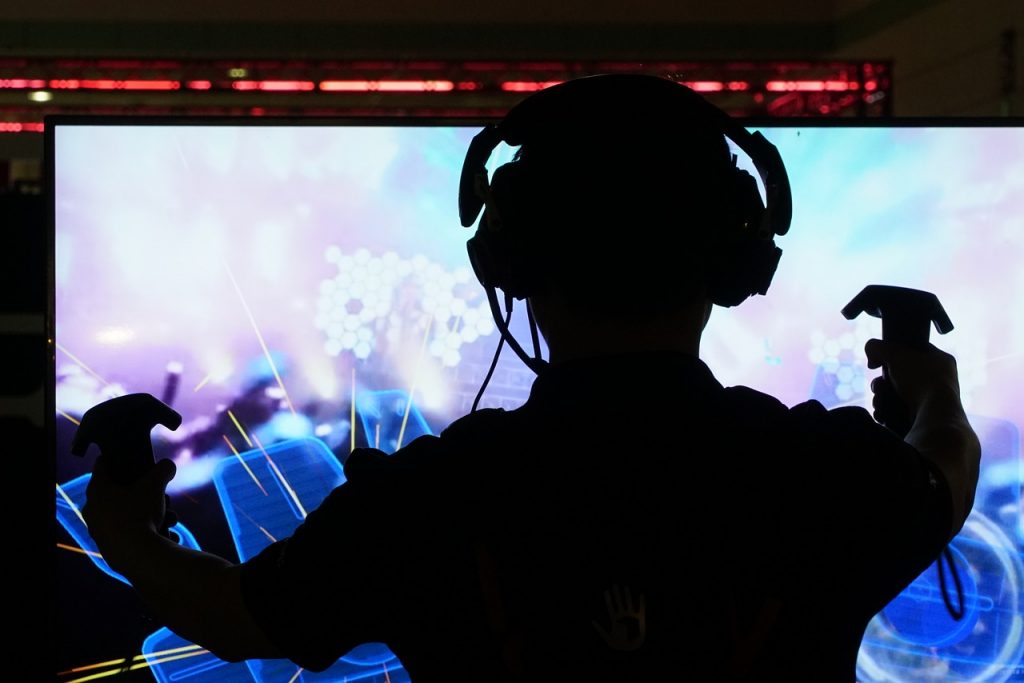 This is a guest post by Anastasios Papadopoulos, a full-stack developer with a passion for writing.
This is a guest post by Anastasios Papadopoulos, a full-stack developer with a passion for writing.
Back to the Future of Gaming
“Video games are going to ruin our lives,” or so many people seem to think (and they may have a point, sort of). If you’re a near-future fiction writer, you may wonder what the future of gaming may look like.
Not all predictions come true: a couple of decades ago, some had claimed that video game addiction would cause the economy to collapse, which now seems unlikely. And in Nicholas’ sci-fi/fantasy series, Pearseus, a whole chunk of humanity ends up in a sort of artificial coma just so they can play their favorite games for eternity.
Even so, some projections do seem more likely. For example, software developers predict that games will have their version of the Oscars or prizes become more like the film industry.
What else can we expect in the near future of gaming?
The (Near) Future of Gaming
To answer that question, we can take a look at new technologies and how these are shaping the future.
The future of gaming offers many possibilities as technology evolves. For example, gaming experience will benefit from faster internet connection speeds and become more immersive.
The integration of available technologies will play an even more significant role, especially after the sweeping success of massive-multiplayer online (MMO) games like Fortnite, the world’s most popular video game.
In early 2019, Netflix stated in its fourth-quarter earnings report that it is facing stiff competition from Fortnite and MMOs in general. Fortnite has had 200 million registered players since launching in June 2017 and generated more than $2.4 billion in revenue as a free-to-play game last year.
Many news headlines like The Wall Street Journal and Axios have noted that gaming is pushing aside other pastimes and hobbies and transforming family and social dynamics. A glance at the numbers in 2019 shows that the gaming industry generated $120 billion in revenue, and experts predict it could reach $200 billion within two years. By 2021, it’s projected that 2.7 billion people — about one-third of the global population — will be gamers.
Leading tech companies like Apple, Google, and Amazon are taking advantage of this trend by developing gaming products. This puts them in direct competition with gaming mainstays like Sony, Nintendo, and Microsoft, so the next few years of gaming are gearing up to be better than ever.
In such a competitive environment, it is technological innovation that will help shape the future of video games.
Artificial Intelligence in Video Games
Artificial Intelligence (A.I.) is one of science fiction’s staples. But it’s also becoming part of our everyday life, with applications like self-driving cars, facial recognition, and video game implementation.
A.I. has been used in gaming for decades — especially in the form of non-player characters (NPCs). From the colorful ghosts in Pac-Man to the town guards in World of Warcraft or an opponent in strategy games, A.I. has been a crucial part of the gaming experience.
Most people probably imagine that the majority of games released in the last couple of years have highly sophisticated A.I. for any non-player-controlled characters. However, this hasn’t always been the case.
Most NPCs are programmed to go along with a script or a simple “if-then” statement: “if the game loads, walk across the river.” Or, “if approaching a guard, prompt the player with a question.”
Most NPCs can strictly do what they have been programmed to by game developers, who seem to believe that more quick-witted NPCs would result in a less fun experience for the gamers.
Over the last years, however, game developers have taken a more advanced programming approach. NPCs now use a so-called behavior tree decision matrix, which permits them to perform more complex decision-making.
The programming design strategy of A.I. in video games is not to create an indomitable NPC for gamers to fight against but to maximize player engagement and entertainment over long periods of time.
Gameplay Creation
For several years now, A.I. has been helping game developers create games and their content.
Game developers can be relieved from composing each individual component by hand by letting A.I. generate most of them. This is done using a technique called procedural content generation, which has become common practice in game designing.
This technique is also used to randomly generate new game levels so the players can have a new adventure each time.
Soon, your game will probably include an A.I. ‘game master’ who’s looking at your gameplay to determine and direct the perfect adventure for you.
Virtual Reality in Video Games
For many years, Virtual Reality (VR) has fascinated gamers with the promise of a captivating experience. But the technology hasn’t yet fulfilled its promise.
Several tech companies are trying to change that by investing more resources in the research and development of VR hardware and games. However, VR is still a fringe technology.
So what’s holding back VR?
The first aspect is simply financial. VR must become widely available to everyone at a low price because at this time it is only for gamers with high disposable income.
The next problem is the weight and size of the headsets. Right now, they are not very comfortable and players get fatigued after 30 minutes. This stands against most gamers’ habit of spending hours pleasantly sunk into a chair or a couch.
Last but not least, even if clearing these hurdles is probably just a matter of time, it remains to be seen whether the pandemic will make people more sociable or less so. In a world where socialization has become essential, the typical VR experience may be deemed socially isolating.
To counter this possibility, most R&D divisions are targeting a future of VR that includes a co-located gaming experience that multiple gamers share.
Hyper-Reality
That leads us into hyper-reality. In the last few years, we see a lot of VR companies that blend virtual reality and physical reality together. Gamers gather up in a physical space, e.g. inside a hangar equipped with obstacles, put on their VR helmets, and wear on their back computers the size of a backpack. They then share the same virtual activity like a quest or a mission.
In contrast with classic VR, in which the whole content is displayed on goggles, hyper-reality players are in a physical space that matches the game content. They can interact with the space around them and the physical objects in it. For example, gamers are able to search for virtual objects, move them around and interact with them — e.g. jump on a box or feel its surface. This interaction creates a unique gaming experience.
The future of VR may well be to incorporate AR elements, giving you the ability to feel real-world objects with your hands, or use your legs to walk in a game.
Augmented Reality Swarms Plazas
Early in the summer of 2016, a “pandemic” broke out. Everyone swarmed parks, roads, and plazas hunting colorful critters called “Pokemons”; creatures that were part of an augmented reality mobile game called “Pokemon Go.” In this game, virtual assets were images that overlay the gamer’s view of the real world.
Since then the game has made 3 billion dollars in sales.
This success wasn’t only because of the technology of AR, as geo-based AR wasn’t something new. However, once it was blended into a game, the interplay between digital characters and physical locations that brought people together became irresistible.
That’s part of the reason why AR is overtaking VR so far.
Mobile 5G Changes the Game World
We are in the early stages of 5G network deployment, which should bring along a much smoother game experience. With each iteration of next-gen gaming, the focus is on enhancement. You can see your current situation by checking your internet connection speed. Speed is one of the most noticeable differences that gamers will experience in the near future. 5G’s speed, improved internet connectivity, and faster services mean that players will enjoy an even more seamless experience.
That’s because the games and technologies require increasingly more real-time data input, especially in mobile devices. Internet speed also plays a significant role in the quality of cloud gaming and cross-platform play.
5G will create a network effect in which a massive number of gamers will be able to play together for a high-quality AR MOM.
Run to the Future
All these technologies and predictions reveal an interesting trait about humanity: for many, yearning to escape often overcomes their desire to connect with real people.
Digital assistants like Alexa and Siri are proof that humans are ready to embrace virtual friends. NPCs will be enhanced digital characters who speak naturally and behave rather like a real-life friend than a bot. All these will be experienced through mixed-reality goggles or mobiles.
The same digital characters could be like a friend with whom gamers play games. At the same time, A.I. will act as game master or game editor.
Even so, the future of entertainment is gaming, and the future of gaming is community. People want to spend time with friends, coworkers, and dates. Games will become the bowling alleys or movie theaters of the past — part of the communal experience and entertainment.
In an interesting twist, players will have the ability to bring a bowling alley or any other game or theme park into their rooms and share the space with avatars controlled by real friends.
And if you’re wondering why to play games in the first place, video games may actually make you smarter!






Interesting article, I cannot really play VR. I get terrible motion sickness which I do not have for most things. Technically, I think it is inevitable that many people, especially young kids, will become gamers. Missy loves her kids games on my phone. She watches me play kids videogames (Let’s Go Eevee) but cannot handle the console and reading the text as a preschooler. There are some games that she is even better than I am and she has to tell me how she did it!
Lol – same here! My 5-year-old also surprises me with how well she can handle the tablet despite being unable to read!
Excellent piece
Thank you, Vincent 😀
My pleasure Nicholas 🙏🏻
Nice article!
I’d add an interesting side-effect of the growth of gaming is the growth of related technologies benefitting non-gamers, as well. I don’t game, myself, but I do 3D animation, where I’m working on short animated “films” of my space opera using software originally designed for games (Unreal Engine). The entry level cost for that is very low, although the more you do, the more you’re likely to buy for it, and there is a pretty large learning curve for the various software that makes it easier (Daz 3D, iClone, etc), as well as trying to convert a written story into a movie-style script, but the possibilities are endless. A friend is starting to learn Unreal to eventually create VR of *his* books.
Imagine, instead of (or in addition to) an audio book add-on, you could have a movie-style version, or VR “movie” of your story worlds…
Warning, though: like gaming itself, animating is highly addictive, and can seriously eat into writing time. 😀
Wow, sounds awesome!!! I envy your skills 🙂
LOL, don’t envy me til I get better at it. 🙂 Right now, still fairly herky-jerky animation with terrible text-to-speech voices, but it’s getting there.
🙂
Hey, it’s still more than I do!